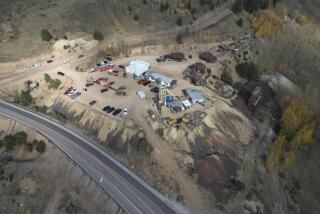Inspiration below ground and above
For the 33 miners who have been trapped half a mile below ground in Chile for more than two months, there is finally light at the end of the tunnel. When drill operator Jeff Hart punched through to the chamber last week, the miners cheered below and their relatives wept with joy, hugging Hart and posing for pictures with him. The Denver resident had been in Afghanistan drilling water wells for the U.S. Army when he was called to the mine in the Atacama desert, and his efforts there are only one example of the extraordinary international effort that, combined with local expertise, has made the 33 miners the longest surviving victims of a mine cave-in. The Chilean authorities have said that they could be rescued as soon as Tuesday night.
The international effort was matched by the inspiring example of those trapped below. The mine collapsed on Aug. 5, and 17 days passed before contact was made through a probe and the world learned of the miners’ determination and discipline. They had stretched a two-day supply of food by living on two spoonfuls of tuna, a sip of milk, a bits of crackers and a nibble of peaches — every other day. And they had maintained order by continuing to follow the directions of the senior miner in the company.
Contact with the world above brought hundreds of government officials, Red Cross workers and volunteers (who prepare 500 meals a day for family members) to the site. It also brought cutting-edge technology to solve the dual challenges of keeping the miners alive and devising a rescue. Twenty private mining companies from around the world — usually rivals — coordinated efforts to penetrate the rock, loaning equipment and personnel; the state-run mining company fashioned a telephone system through a second probe hole. The miners have received, food, water, medicine, dominoes, MP3 players and videos to ward off depression, and they have traded letters with family members. One man proposed to his girlfriend; another promised his wife the honeymoon they never had. The U.S. National Aeronautics and Space Administration sent a team to Chile to share expertise about the psychological and physical toll of living in cramped quarters, and when the miners exercise — to be rescued, they must fit into a capsule called the Phoenix, whose diameter is less than two feet — they wear gear that is standard for astronauts and which monitors their heart, lung and other functions. When they are finally brought out into the light they will wear special sunglasses provided by Oakley, based in Orange County.
On Monday, the capsule, whose components were designed by 20 NASA engineers, completed a successful trial run. And if it rises later this week, as expected, carrying the first miner, the greatest joy will be in Chile, but the job well done will belong to many.
More to Read
Sign up for Essential California
The most important California stories and recommendations in your inbox every morning.
You may occasionally receive promotional content from the Los Angeles Times.










